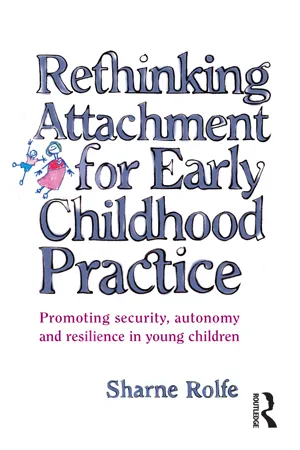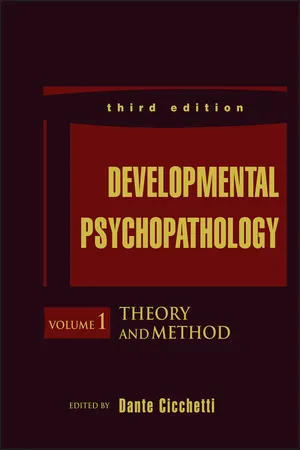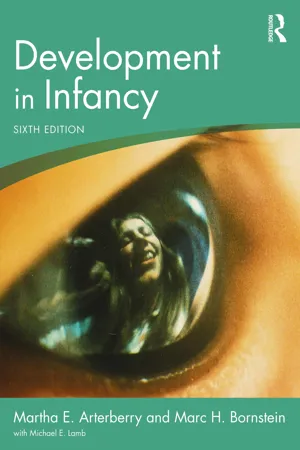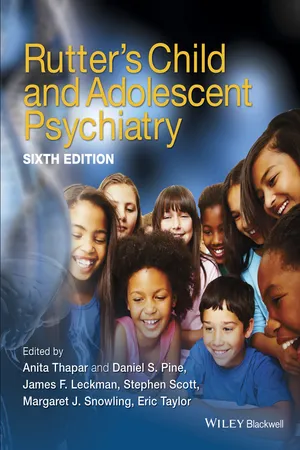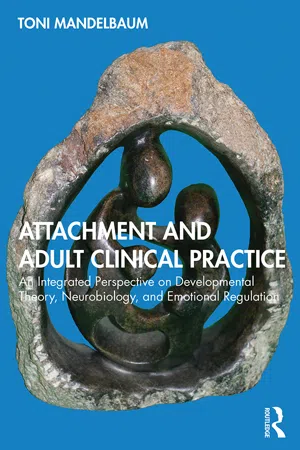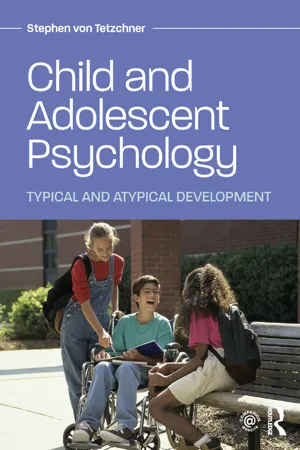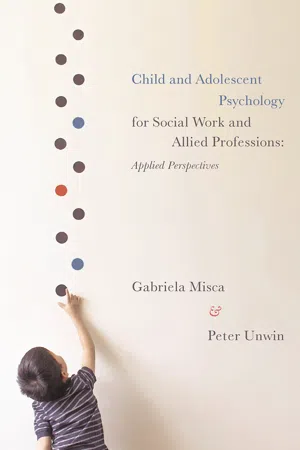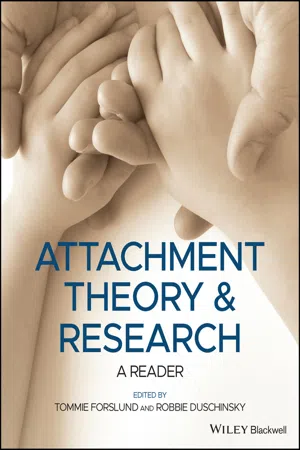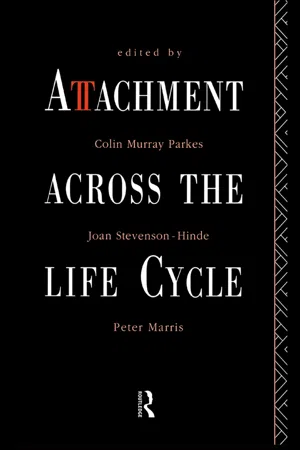Psychology
Stages of Attachment
The stages of attachment refer to the sequence of emotional bonds that infants form with their primary caregivers. The stages include pre-attachment (birth to 6 weeks), attachment-in-the-making (6 weeks to 6-8 months), clear-cut attachment (6-8 months to 18 months), and formation of reciprocal relationships (18 months and beyond). These stages are crucial for the development of secure and healthy attachments in childhood.
Written by Perlego with AI-assistance
Related key terms
Related key terms
1 of 4
Related key terms
1 of 3
10 Key excerpts on "Stages of Attachment"
- eBook - ePub
Rethinking Attachment for Early Childhood Practice
Promoting security, autonomy and resilience in young children
- Sharne A Rolfe(Author)
- 2020(Publication Date)
- Routledge(Publisher)
Issues of importance to the early childhood professional during these stages of development are identified, including the growth of autonomy, and links between security of attachment and cognitive competence. Attachment formation The attachment relationship takes time to develop. From the infant's perspective, attachment is not present at birth. It emerges over time. The process first involves the ability to discriminate between different people, then increasing preference for one or a small number of primary caregivers who thereby gradually assume the role of attachment figures. Achieving security and feelings of trust during this process is the primary developmental task of the first 12 months. As already discussed in chapter 2, both infant and caregiver contribute to the nature of the attachment relationship that forms. In essence it is how, and whether, the dyad achieves ' dynamic equilibrium' (Bowlby, 1969/1982, p. 236) in their attachment behaviours that determines the quality of the relationship, and hence its effect on the child's emotional development. By dynamic equilibrium Bowlby meant achieving a stable and presumably comfortable balance in the attachment dyad between closeness and proximity on the one hand, and the demands of competing needs on the other. In the infant these competing needs include exploration, and in the adult the pulls of other responsibilities, interests, feelings and desires. In chapter 2, we considered how the infant is born with a set of behaviours that mediate the development of attachment, including crying, clinging and visual orientation. These are added to soon after by behaviours such as smiling and babbling, and later still by the emergence of locomotion and following. The young infant demonstrates an amazing range of sensory and perceptual capabilities - eBook - ePub
- Dante Cicchetti, Dante Cicchetti(Authors)
- 2015(Publication Date)
- Wiley(Publisher)
formation of a goal-corrected partnership (beginning at around 3 years) between the child and caregiver. With the development of language and other cognitive skills, the child becomes able to consider the mother's perspective and consider her wishes in guiding the child's behavior. Thus, the relationship becomes more like a partnership, whereby the child weighs both the parent's and his or her own goals in planning behavior, and attachment needs can increasingly be negotiated collaboratively between parent and child.Inherent in this view of development is the idea that personality becomes increasingly complex at every stage of development and that, with development, the child becomes a stronger force in determining developmental pathways (Bowlby, 1969). Thus, Bowlby believed that early social experiences have important implications for subsequent development, with initial adaptations within relationships with primary caregivers serving to lay the foundations for subsequent development. In addition, Bowlby proposed that early experiences color encounters with later experiences through the action of working models, or cognitively embedded abstractions of direct experiences with caregivers. As will be described in more detail, such working models are carried with individuals into novel situations, informing expectations and behavior in interpersonal contexts.Thus, it is fair to say that in its initial formulations, Bowby's attachment theory was primarily concerned with the fundamental nature of attachment, its evolutionary and biological dimensions, its development, and the impact on personality development of major disruptions to the integrity of the attachment bond, such as permanent or lengthy separation, or bereavement. It was through his collaboration with Mary Ainsworth that the theory broadened to incorporate variations in the quality, or security, of attachment in circumstances where no major disruptions to the integrity of the bond had occurred. This represents a critical turning point for attachment research in two fundamental respects. First, with this new perspective and the now-famous tools that Ainsworth and others developed for rigorously assessing individual differences in the organization or quality of attachment there opened up a highly tractable set of scientific possibilities that were to generate a vast wealth of important findings that has given the field much of its momentum ever since. Second, it represented a shift of focus to a different set of populations—initially children experiencing major separation or privation of attachment experiences, then subsequently to children having experienced a continuous and unbroken bond with their stable caregiver (in most cases their biological parent), but who vary in how their attachment relationship and their own attachment behavior is organized. Crucially, this shift moved the field to focus on fundamentally different aspects of attachment. Bowlby's early thinking was focused on the mechanisms by which a bond is established and what effects occur when it is disrupted. The later work on attachment tended not to address this, and instead examined how attachment behavior toward a consistent caregiver is shaped by that caregiver's behavior, particularly sensitivity. - eBook - ePub
- Martha E. Arterberry, Marc H. Bornstein(Authors)
- 2023(Publication Date)
- Routledge(Publisher)
Chapter 2 .KEY TERMSAttachmentsspecific, enduring emotional bonds, the first of which are often with parentsCHAPTER OVERVIEWDevelopment of attachmentIndividual differences in attachmentAttachment across cultural contextsParent–infant interactionGender stereotypes and socializationWhat are the phases of caregiver–infant attachment?
A number of developmental theories emphasize the importance of child–caregiver interactions, but no theory has been as enduring as that formulated by Bowlby (1969 ; Grojman-de-Millan et al., 2017 ; Thompson et al., 2021 ). Bowlby, a psychoanalyst, was impressed by the capacity of ethological theorists to explain early emotional communications and the formation of social bonds in nonhuman species. (Ethology is the scientific study of animal behavior, often making cross-species comparisons.) One assumption of the ethological perspective is that the behavioral propensities of infants and parents are best considered in the context of the “environment of evolutionary adaptedness” in which our species evolved. There the survival of infants depended on their ability to maintain proximity to protective adults to obtain nourishment, comfort, and security. Unlike the young of many other species, human infants are unable to move closer to or physically follow adults for several months after birth, and they are even incapable of clinging to adults to stay in contact. Instead, human infants have to rely on signals of various sorts to entice adults to approach and stay near them. For these signals to be effective, adults must be predisposed to respond to them. A good example of such a signal is crying, which very effectively entices adults to approach, pick up, talk to, and soothe infants (Bornstein et al., 2017 ; Esposito & Bornstein, 2019 ; Yoo et al., 2018 - eBook - ePub
- Anita Thapar, Daniel S. Pine, James F. Leckman, Stephen Scott, Margaret J. Snowling, Eric A. Taylor, Anita Thapar, Daniel Pine, James F. Leckman, Stephen Scott, Margaret J. Snowling, Eric A. Taylor(Authors)
- 2015(Publication Date)
- Wiley-Blackwell(Publisher)
Chapter 6 Attachment: normal development, individual differences, and associations with experience Mary Dozier1 and Kristin Bernard21 Department of Psychological and Brain Sciences, University of Delaware, Newark, DE, USA2 Department of Psychology, Stony Brook University, Stony Brook, NY, USAAccording to John Bowlby (1969/1982), the attachment system evolved to enhance reproductive fitness. Infants develop attachments to figures who are “older and wiser” than themselves and seek to maintain proximity with these attachment figures under threatening conditions. The infant's behavioral repertoire of crying, smiling, clinging and following represents an organized system, designed to maintain or restore proximity to the caregiver (Sroufe & Waters, 1977a, b; Bowlby, 1988). By the time the infant is capable of crawling or walking, the attachment system has developed fully such that the infant does not want to move far from the parent except when circumstances are familiar (Bretherton, 1985). Under conditions of threat, when proximity is especially important to survival, the need for proximity to the caregiver is intensified (Bowlby, 1969/1982; Rutter et al., 2009). For example, when the infant is fearful of a stranger or a startling sound, the caregiver is sought out for protection, with the response intensified in proportion to the perceived threat. Given the basic evolutionary function of this system, attachments are expected to develop in virtually all ordinary childrearing conditions. Although the attachment system may have special significance for the infant, attachments are thought to remain important for humans throughout life.Historical context of the development of attachment theory
Attachment theory was developed in response to psychoanalytic and social learning theories of the time, and in the context of observations of the pernicious effects of privation on human and non-human young, and a burgeoning literature on ethology and evolution. John Bowlby articulated what has come to be known as attachment theory. Mary Ainsworth played a critical role as an astute observer of individual differences in attachment, and on the basis of these observations, in developing a system for classifying infants' attachment quality. - eBook - ePub
Attachment and Adult Clinical Practice
An Integrated Perspective on Developmental Theory, Neurobiology, and Emotional Regulation
- Toni Mandelbaum(Author)
- 2020(Publication Date)
- Routledge(Publisher)
Chapter 5The developmental pathway of attachment
As one can gather, a great deal of attachment research has focused on classifying or categorizing children and adults as secure, insecure, or disorganized with respect to attachment. Overall, this has been incredibly beneficial to the field, allowing empirical research to flourish, validating more concepts and aspects of social science than had ever been validated before. However, the emphasis on classification has often allowed researchers to overlook the process of how an attachment bond forms, develops, and functions dynamically (Slade, 2004). As Fonagy (2001) notes, while many of Bowlby’s cohorts’ theories led to new schools of psychoanalytic therapy, Bowlby’s ideas did not. His focus on empirical investigation created increased distance between him and the psychoanalysts of the day, setting a trend that continued until fairly recently.It was developmental researchers who began to further their thinking and to attempt to better understand the process of attachment formation. Did the attachment bond develop in a linear manner and become fixated at certain points, as Freud had posited? Was the caregiver completely in charge of the attachment bond’s development while the baby remained a passive participant, or did the baby have the ability to have a say in the matter? Do babies and caregivers communicate? If so, how do they do this without words? How does a secure or insecure baby become a secure or insecure adult, as empirical research seems to indicate? And, what role did social relationships, and in particular the caregiver–child dyad, play in the emergence of the self?These were some of the fundamental questions developmental theorists began to tackle. They turned to the work of Louis Wilson Sander (1918–2012), a child psychiatrist, who studied personality development, and whose research provided evidence to attachment theorists that the self is a social creation, emerging from within the caregiving relationship system (Sroufe, 1989). When Sander completed his training in child psychiatry at the Judge Baker Guidance Center, a Harvard Medical School affiliate, he joined a research team studying the early mother–child relationship. Launched in 1954, this was a naturalistic, longitudinal study in much the same vein as was Ainsworth’s naturalistic, observational study. From this study, Sander (1962; 1975) was able to chart a basic course of development for babies from age zero to 36 months. He emphasized that though there is a general path for development (see below), each infant develops in a unique way in order to adapt to its unique dyadic caregiving system and external surroundings. The caregiver needs to adapt to and accommodate the changing needs of the child across development (Sander, 2000; Sroufe, 2000). In the end, much like Bowlby had concluded, Sander determined that the quality of the infant–caregiver relationship is essential to an individual’s developmental trajectory (Sroufe, 2000). - Daniel P. Keating, Hugh Rosen(Authors)
- 2013(Publication Date)
- Psychology Press(Publisher)
Even so, the infant assumes an early and active role in the construction of attachment relationships through the development of rudimentary relational expectations, the exercise of affective self-regulation related to attachment system functioning, and the child's own dispositional characteristics. It is, in short, the interaction of the child's developing relational and representational competencies with an equally dynamic social context that tells us most about the construction and reconstruction of social attachments. Furthermore, the nature of this interaction necessarily changes with the child's development. Such a view is optimistic with respect to both normal and atypical development, because it affirms the inherent flexibility in early social relationships. Infants who start out with an insecure attachment are not doomed to later psychosocial dysfunction, if their conditions of care change appreciably. Nor are they necessarily acquiring enduring internal representations of relationships that will result in later problems in childhood or as adult caregivers. Instead, it appears that our concepts of ourselves and others as social partners are long in developing and are subject to multiple and diverse influences in the early years. This flexibility— part of our biological heritage—engenders optimism for the range of intervention possibilities that exist in infancy and throughout the lifespan. ACKNOWLEDGMENTS I am grateful for the valuable comments of Michael Lamb on an earlier draft of this chapter. REFERENCES Ainsworth, M. D. S. (1973). The development of infant–mother attachment. In B. Caldwell & H. Ricciuti (Eds.), Review of child development research (vol. 3, pp. 1–94). Chicago: University of Chicago Press. Ainsworth, M. D. S. (1983). Patterns of infant–mother attachment as related to maternal care. In D. Magnusson & V. Allen (Eds.), Human development: An interactional perspective (pp. 35–55). New York: Academic. Ainsworth, M. D. S., Blehar, M- eBook - ePub
Child and Adolescent Psychology
Typical and Atypical Development
- Stephen von Tetzchner(Author)
- 2018(Publication Date)
- Routledge(Publisher)
19 ATTACHMENTF rom birth throughout the life span, human beings are oriented toward social stimulation and participation, making social relations a core area of developmental psychology. This chapter is about children’s early social relations and the influence they may have on the child’s social functioning and development. According to attachment theories, early close relationships provide children with knowledge about social relations that form the basis for how they meet other people and contribute to forming their later reactions and behaviors.Attachment behavior is defined as “any behavior that results in a person attaining or maintaining proximity to some other clearly identified individual who is conceived as better able to cope with the world” (Bowlby, 1982, p. 669). Thus, the function of attachment behaviors is to ensure a feeling of safety by reducing the physical distance to specific individuals, attachment figures. If a child’s attachment system is to perform its function, attachment figures must respond to the child’s attachment behavior. Adults react to signaling behavior by reducing the distance to the child when necessary, calling the child or moving closer when the distance exceeds a certain limit, for example when the child has wandered off (Bowlby, 1969).THEORETICAL PERSPECTIVES ON ATTACHMENT
Views differ with regard to the basis of attachment and the possible outcomes of different types of attachment. John Bowlby presented the first comprehensive theory of attachment and laid the foundation for all later theories (Hinde, 2005). Bowlby’s ethological theory will therefore be presented first and in particular detail, although some other views predated his.Seeking security by the mother.Ethological theory
Attachment has to do with relationships, whose biological basis, according to Bowlby (1969), is survival. From an evolutionary perspective, the survival value of attachment behavior lies in the fact that human infants would be unable to survive without a caregiver. The same applies to infant monkeys, although their development is somewhat faster (Suomi, 2008). The imprinting behavior of ducks and other birds seems to fulfill a similar function as attachment behavior in humans (see Figure 19.1 - eBook - ePub
Child and Adolescent Psychology for Social Work and Allied Professions
Applied Perspectives
- Gabriela Misca, Peter Unwin(Authors)
- 2018(Publication Date)
- Bloomsbury Academic(Publisher)
Attachment is conceptualized as a dyadic and reciprocal relationship where infants elicit proximity seeking behaviours to gain a response with the ultimate aim of ensuring survival (Bolen, 2000). Originally individuals were thought of as being biologically programmed to form an emotional bond with their primary caregiver to ensure survival and proximity. One of the predictions is that failure to initiate a bond with the primary caregiver or the formation of insecure attachment within the first two years of life severely inhibits cognitive, social and physical development (Atwool, 2006).Attachment is thought to develop typically around 8 months when proximity seeking behaviours emerge (Bretherton, 1992). Bowlby (1980) suggested that these early experiences are internalized and individuals develop an IWM which promotes stability of attachment behaviours and development across the life course, although some research posits that life experiences increase the likelihood of IWM malleability (Atwool, 2006). The works of Ainsworth and Bowlby (1991) revolutionized our understanding of how separation, privation and deprivation influence development (Bretherton, 1992).How is the quality of attachment relationship measured?The standard method employed in studies for assessing attachment type in infancy is the Strange Situation Procedure developed by Ainsworth and Bell (1970). On the basis of reunion behaviours in the Strange Situation Procedure, infants are classified as securely or insecurely attached, the latter being divided into three subgroups: avoidant, ambivalent or disorganized attachment styles.Secure children use the caregiver as a safe base from which they can explore the environment, seek direct comfort from their caregiver and are easily soothed upon reunion. Avoidant children reduce their attachment distress and seem to be more interested in exploration. Ambivalent-resistant children display increased attachment needs and are difficult to soothe when distressed. Lastly, disorganized children do not demonstrate a particular strategy for protection and exhibit illogical behaviour such as freezing upon reunion and hand flapping.Reflective point➢ - eBook - ePub
Attachment Theory and Research
A Reader
- Tommie Forslund, Robbie Duschinsky, Tommie Forslund, Robbie Duschinsky(Authors)
- 2021(Publication Date)
- Wiley-Blackwell(Publisher)
3 Attachment Mary D. Salter Ainsworth“Attachment” is a term inextricably linked to the contribution of John Bowlby. His theory of attachment, although focused on the nature and development of affectional bonds, is a comprehensive psychological theory encompassing issues of motivation, emotion, and cognition as well. Although in his earliest statements it appeared to be concerned primarily with the normal course of development, his aim from the beginning was to account for individual differences in intimate relationships and the way they are handled, including some developmental outcomes that may be clearly identified as pathological. It is an open‐ended theory that, from its earliest formulations, has stimulated research which in turn has influenced later theoretical formulations. Both theory and research have had an impact on child‐care practices, especially in hospitals, residential institutions, and social agencies. It is the intent of this chapter to present the essentials of attachment theory and to consider the findings of some of the research to which it has given rise. This review has to be highly selective; the literature has become so voluminous that it is impossible in one chapter to refer to all the relevant research or to consider reformulations of attachment theory stemming from other theoretical paradigms.Deprivation and Separation
Bowlby’s starting point was research stemming from the hypothesis that separation from the mother in early childhood could lead to pathological outcomes that were difficult to reverse (Bowlby, 1944 ). Subsequent reviews of the literature (Ainsworth, 1962 ; Ainsworth & Bowlby, 1953 ; Bowlby, 1952 ) led to a distinction between “maternal deprivation” as insufficiency of interaction of a child with the mother figure and “mother–child separation” as discontinuity of the bond of child to mother after it had become established. Although prolonged deprivation beginning before an infant had become attached to its mother was shown to have a very adverse effect on development (e.g., Goldfarb, 1943 ), in most of the research literature deprivation and separation were confounded, dealing with infants and young children removed from home and parents to whom they had already become attached and placed in an unfamiliar environment among unfamiliar caregivers, none of whom had sufficient interaction with the child to substitute as an adequate mother figure. Noting similar adverse effects, Bowlby directed research that shifted its main focus from outcome to process in an attempt to understand the sequence of responses a young child shows when separated under depriving circumstances and, also, to account for the sequence of readjustments in the child’s behavior toward his or her family when eventually they are reunited. These responses are reviewed in the introductory sections of each of the three volumes of his Attachment and Loss series (Bowlby, 1969 , 1973 , 1980 - eBook - ePub
- Colin Murray Parkes, Joan Stevenson-Hinde, Peter Marris, Colin Murray Parkes, Joan Stevenson-Hinde, Peter Marris(Authors)
- 2006(Publication Date)
- Routledge(Publisher)
Part IThe Nature of Attachment
Passage contains an image
Chapter 1 The roots and growing points of attachment theory
1Inge Bretherton
Attachment theory in its current form is the joint work of John Bowlby and Mary Ainsworth. John Bowlby, using concepts from ethology, cybernetics, and psychoanalysis, formulated the basic outlines of the theory. We owe to him a new way of thinking about the infant’s tie to the mother, and its disruption through separation and deprivation. Mary Ainsworth not only translated the basic tenets of attachment theory into empirical findings, but also helped us to expand the theory itself. Her two major theoretical contributions were the explanation of individual differences in attachment relations and the concept of the caregiver as secure base.This paper delineates the historical development of attachment theory. It is divided into four parts. First, I show that the basic ideas guiding both protagonists’ later contributions have roots in their early professional career. I then go on to discuss the development of the theory, laying out the sequence in which Bowlby proposed its basic postulates at the same time as Mary Ainsworth began to test and expand them in her empirical studies. The third part of the paper is devoted to a brief review of work on the validation and consolidation of attachment theory. Finally, I discuss future directions of attachment theory and research.ROOTS
John Bowlby
John Bowlby was born in 1907. I am sure that experiences in his childhood must have played a role in directing his interest toward the study of attachment. However, Bowlby himself begins his intellectual autobiography with studies at the University of Cambridge where he read medicine, upon the advice of his surgeon father (see interviews with Senn (1977a) and Smuts (1977)). In his third year of study, John Bowlby became drawn to what would later be known as developmental psychology, and he temporarily gave up plans for a medical career.
Index pages curate the most relevant extracts from our library of academic textbooks. They’ve been created using an in-house natural language model (NLM), each adding context and meaning to key research topics.
Explore more topic indexes
Explore more topic indexes
1 of 6
Explore more topic indexes
1 of 4
